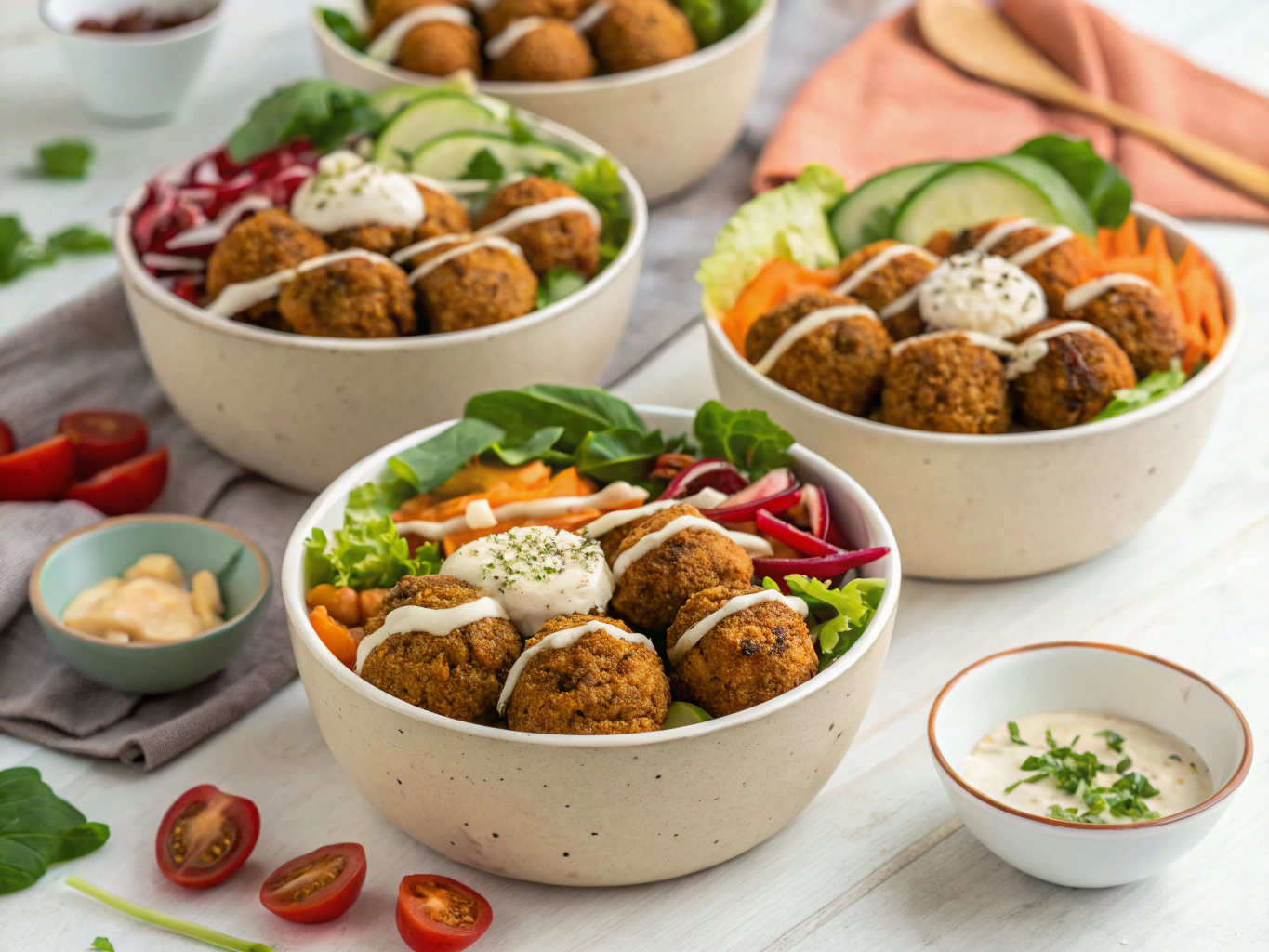
Looking for a deeply satisfying dish that balances crunchy textures, vibrant colors, and bold Mediterranean flavors? Falafel bowls are a delicious, visually stunning, and nutritious way to enjoy plant-based eating without sacrificing comfort. This article breaks down how to make falafel bowls from scratch, from my personal kitchen experience to ingredients, step-by-step instructions, serving tips, and expert FAQs. Whether you’re meal-prepping for the week or hosting a vibrant dinner party, this guide will help you master your own version of falafel bowls with confidence. Let’s dig into the tenderness, crunch, and tahini-drizzled magic that is this Middle Eastern-inspired favorite.
The Story Behind My Falafel Bowls (and How You Can Make Them Yours)
From Grandma’s Counter to My Charleston Kitchen
My story with falafel bowls didn’t start with a recipe card—it began with a craving. Back when I ran a small food truck experiment in Charleston’s downtown market, folks kept asking for dishes that were bright, healthy, and filling. I remembered the crispy chickpea fritters my grandmother experimented with when trying new foods she saw on PBS cooking shows, and I decided to reinvent them into hearty falafel bowls with Southern flair.
Now, I serve these at home for dinner, or pack them up for breezy beach picnics. Falafel bowls are deeply customizable and brilliantly satisfying. They speak to all my favorite kitchen principles: bold flavors, simple techniques, and ingredients you can pronounce. You don’t need a deep fryer or a rare spice collection—just a few pantry staples, some patience with your food processor, and fresh veg from your local farmers’ market.
I’ve played with plenty of variations, and what’s been most exciting is folding familiar comfort food vibes into each bite—like citrus-marinated red cabbage for tang or roasted sweet potato cubes for warmth. The beauty of falafel bowls is that they can be as traditional or as wild as you like, and you’ll always come back to them because they feel like a hug in a bowl.
Why Falafel Bowls Deserve a Spot in Your Weekly Rotation
Falafel bowls are more than just trendy meal-prep fare—they’re deeply rooted in tradition and endlessly versatile. They’re a powerhouse of plant-based protein thanks to chickpeas, and they pack in fiber, iron, and flavor with zero need for meat or dairy. Whether you’re creating a grain base with fluffy quinoa or jazzing things up with herbed millet, every element is a chance to play with texture and flavor.
What makes them so appealing is their flexibility—toss in leftover roasted veggies, pickled onions, or a dollop of hummus, and you’ve upped the ante. At FlavivoRecipes, I’m all about helping folks add creativity to comforting dishes, and falafel bowls show just how far the basics can take you. I’ve even paired mine with smoky tomato lentils for a seriously hearty twist.
Building the Perfect Falafel Bowl
Ingredient List with Substitutions and Twists
Creating unforgettable falafel bowls starts with a few base elements: crispy falafel, a hearty grain or green base, vibrant vegetables, salty-sweet add-ins, and a creamy, tangy sauce. Here’s what you’ll need:
- 1 ½ cups dried chickpeas (soaked overnight, not canned!)
- 1 small onion, roughly chopped
- 2-3 garlic cloves
- ½ cup fresh cilantro
- ½ cup fresh parsley
- 1 teaspoon ground cumin
- 1 teaspoon ground coriander
- ½ teaspoon cayenne or chili flakes
- ½ teaspoon baking soda
- Salt, to taste (around 1 tsp)
- 2 tablespoons flour (or chickpea flour)
For the Bowl Base and Add-ins:
- 2 cups cooked quinoa or couscous
- 1 cup chopped cucumber
- 1 cup halved cherry tomatoes
- 1 cup shredded red cabbage
- 1 small sweet potato, cubed and roasted
- Pickled onions or olives for garnish (optional)
Suggested Sauce:
- ½ cup tahini
- Juice of 1 lemon
- 1 garlic clove, grated
- Salt + water to thin
Substitutions:
- No fresh herbs? Use 1 teaspoon dried, though fresh gives better flavor.
- For a gluten-free version, use gluten-free flour or ground oats.
- Swap quinoa for barley with garlic oil or even massaged kale.
Prep and Cook Time Breakdown
You don’t need to block out your entire day to make falafel bowls. Here’s a realistic time estimate:
| Task | Time |
|---|---|
| Chickpea Soaking (prep ahead) | 12 hrs (overnight) |
| Falafel Mixing & Forming | 25 minutes |
| Cooking Falafel (air-fry/pan-fry) | 15–20 minutes |
| Assembling Bowls | 10 minutes |
You’re looking at just under one hour active cooking time once your chickpeas are soaked—a small investment for a super satisfying meal.
How to Make Falafel Bowls Step-by-Step
- Soak your dried chickpeas in cold water overnight for at least 12 hours.
- Drain chickpeas and add them to a food processor with onion, garlic, herbs, spices, salt, and flour. Pulse until you get a coarse, sticky mixture that holds together when pressed. Let it rest in the fridge for 30 minutes.
- Shape mixture into small balls or patties. Don’t worry if they’re imperfect—rustic is beautiful!
- Cook falafel by air-frying at 375°F for 15 minutes, pan-frying in avocado oil, or baking at 400°F for 25 minutes, flipping halfway.
- While falafel cooks, roast your cubed sweet potato (tossed in olive oil, salt, and cumin) until golden.
- Mix tahini, lemon, garlic, and salt with just enough warm water to make it drizzle-worthy.
- Build your bowl: quinoa > fresh veg > warm falafel > drizzled sauce > garnish with herbs or pickled onions.
For added nutritional info, check out USDA’s chickpea nutrition data highlighting their excellent protein and fiber profile.
Easy Customizations and Storage Options
Add Global Flavors to Make It Your Own
One of the best parts of falafel bowls is they’re a blank canvas. Want heat? Add harissa to your sauce. Craving more crunch? Top with crispy shallots. When I’m feeling indulgent, I’ll add fried plantain slices on the side—a nod to southern seasoning with Mediterranean roots. Combine leftover grilled veggie skewers or even a dollop of cashew lime crema for a crossover that sings.
Swap the base with farro, spiced couscous, or even chunky mashed potatoes—seriously, don’t knock it till you try it. The key is balancing saucy elements with crunch and freshness.
How to Store and Reuse Components
Falafel bowls are ideal for meal prep. Store the falafel separately from fresh veg to keep everything crisp. Here’s how I break it down:
- Falafel stays good in the fridge for 5 days.
- The sauce keeps for 7 days in a sealed jar.
- Grains like couscous or quinoa stay fluffy for 4 days.
Want to freeze falafel? Absolutely. After cooking and cooling, freeze in a single layer on a tray, then transfer to a container. Reheat in the oven at 375°F until revived and crisp.
FAQs About Falafel Bowls
What should I put in my falafel bowl?
You can load falafel bowls with grains like quinoa or bulgur, fresh veggies (cucumber, tomato, cabbage), roasted elements like sweet potatoes or eggplant, herbs, and sauce. Add-ins like hummus, pickles, olives, or seeds provide extra texture and flavor.
Are falafel bowls healthy?
Yes, falafel bowls are rich in fiber, plant protein, and healthy fats. Opt for air-fried falafel and olive oil-based dressings to keep things nutritious. Including varied vegetables enhances the range of nutrients in one meal.
What is the best sauce for falafel bowls?
Classic tahini-lemon sauce is a go-to, but yogurt-based sauces, zhoug, or a spicy harissa vinaigrette work beautifully. Even a quick avocado mash with lime takes it to another level.
What is the best binder for falafel?
Traditional falafel uses chickpea flour or plain all-purpose as a binder. Adding a little baking soda helps with a light texture. Avoid eggs—they’re not authentic and make the mix too wet.
Final Thoughts: Make Falafel Bowls Your Own Signature Dish
At the heart of falafel bowls is a celebration of simple ingredients made magical. Whether you’re building them from scratch like I do every Sunday afternoon, or making shortcuts with batch-prepped elements, you’re choosing bold flavor without fuss. These bowls fit tenderly into weeknight dinners or lunchboxes, and they adapt to whatever vegetables and sauces you’ve got on hand.
So go ahead—be playful with your toppings, double that garlic if your heart says so, and never stress over perfect shape or texture. Cooking should be joyful, a little messy, and always learned from the soul. These falafel bowls are yours now—serve them with passion.
Ready to explore more easy comfort meals? Check out my vegan black bean chili for another cozy classic.
